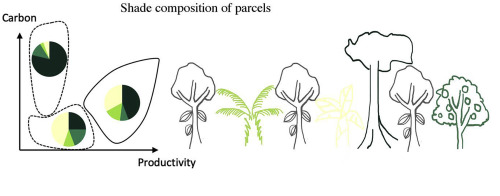Global Ecology and Conservation ( IF 4 ) Pub Date : 2020-01-23 , DOI: 10.1016/j.gecco.2020.e00919 Héloïse Tschora , Francesco Cherubini

|
Agroforestry is a land management practice where trees are grown around or among crops or pastureland. This integration of agriculture and forestry is frequently seen as an option that can secure food security and co-deliver a range of environmental benefits. However, quantitative studies simultaneously integrating multiple aspects of agroforestry are rare. Focusing on four sustainability goals, namely adaptation to climate change, biodiversity conservation, climate change mitigation and rural development, this study investigated co-benefits and adverse side-effects of shaded agroforests above cocoa, coffee, oil palm, banana and citrus plantations in tropical humid West Africa. Time series of remote sensing land cover datasets were used to quantify and map recent land cover transitions in the region, and a field study in 25 agroforestry plots in Togo provided biomass carbon measurements in over 3000 trees, in addition to local farmers interviews. Estimates of theoretical agroforestry expansion and associated carbon sequestration potential in the region were compared to regional emissions from fossil fuels and deforestation. We found that about 1.6 Mha of losses in evergreen forests occurred between 1992 and 2015 (corresponding to 17% of the forest area originally present in 1992), while agricultural areas increased by 2.4 Mha (+5% relative to 1992). On average, trees in the studied agroforestry plots store 83.7 ± 7.0 t C/ha. We found synergies between rural development and adaptation benefits, no clear relationship between biodiversity and carbon storage, and a trade-off between high carbon stocks and crop yields. This trade-off can be minimized with an optimal management of agroforestry by using a mix of tree species that store medium carbon stocks and can enhance yields, soil fertility and climate resilience. In general, plant functional diversity, i.e. a balanced mix of shade trees, fruit trees, palms and bananas, emerged as a key feature of successful agroforestry systems. Besides, agroforestry trees co-products are reported as an additional, diversified source of income for local farmers. A large-scale deployment of agroforestry over seven countries in West Africa can sequester up to 135 Mt CO2/year over two decades, corresponding to about 166% of the carbon emissions from fossil fuels and deforestation in the region. Overall, agroforestry practices in tropical humid West Africa offer multiple-win solutions that are relevant to address major local and global environmental challenges. Increasing cooperation among local farmer communities, national authorities, and international organizations are instrumental to overcome the barriers for a future expansion of agroforestry systems in the region.
中文翻译:

农林业的共同利益和折衷方案,以缓解西非的气候变化和其他可持续性目标
农林业是一种土地管理实践,在农作物或牧场周围或之间种植树木。农业和林业的这种一体化通常被视为可以确保粮食安全并共同带来一系列环境利益的选择。然而,很少同时进行农林业综合多个方面的定量研究。着眼于四个可持续性目标,即适应气候变化,生物多样性保护,缓解气候变化和农村发展,本研究调查了热带地区可可,咖啡,油棕,香蕉和柑桔人工林上方的荫蔽农林的共同效益和不利副作用。西非潮湿。遥感土地覆盖数据集的时间序列用于量化和绘制该地区最近的土地覆盖变化,在多哥的25个农林地块进行的实地研究,除了对当地农民的采访外,还提供了3000多棵树的生物量碳测量值。将该地区理论农用林业扩张和相关碳固存潜力的估算值与化石燃料和森林砍伐的区域排放量进行了比较。我们发现,1992年至2015年间,常绿森林的损失约为1.6 Mha(相当于1992年原始森林面积的17%),而农业面积增加了2.4 Mha(相对于1992年增加5%)。平均而言,所研究的农林业用地中的树木储存量为83.7±7.0 t C / ha。我们发现,农村发展与适应效益之间存在协同作用,生物多样性与碳储存之间没有明确的关系,高碳储量与农作物产量之间也需要权衡取舍。通过使用混合树种来存储农用林业,该混合可以存储中等碳储量,并可以提高产量,土壤肥力和气候适应力,从而可以最大程度地减少这种折衷。总的来说,植物功能的多样性,即阴影树,果树,棕榈树和香蕉的平衡混合,已成为成功的农林业系统的关键特征。此外,据报道,农林业树木副产品是当地农民额外的,多样化的收入来源。在西非七个国家大规模部署农用林业,可以封存多达135吨二氧化碳 棕榈和香蕉已成为成功的农林业系统的关键特征。此外,据报道,农林业树木副产品是当地农民额外的,多样化的收入来源。在西非七个国家大规模部署农用林业,可以封存多达135吨二氧化碳 棕榈和香蕉已成为成功的农林业系统的关键特征。此外,据报道,农林业树木副产品是当地农民额外的,多样化的收入来源。在西非七个国家大规模部署农用林业,可以封存多达135吨二氧化碳2 /年以上的二十年中,对应于从该区域的化石燃料和森林砍伐的碳排放的约166%。总体而言,西非热带湿润地区的农林业实践提供了多重共赢的解决方案,这些解决方案可应对主要的本地和全球环境挑战。地方农民社区,国家当局和国际组织之间日益加强的合作有助于克服该地区未来农林业系统扩展的障碍。



























 京公网安备 11010802027423号
京公网安备 11010802027423号